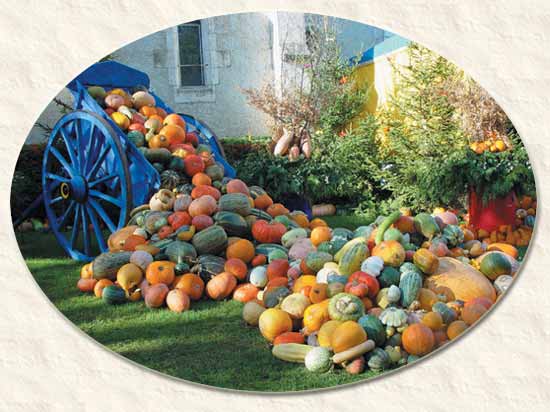
Kokopelli Seed Foundation believes that the only way towards world food security is free access to open-pollinated seeds and revival of sustainable organic agriculture. What is the future of a civilization which is destroying the seeds and the soil? -- Kokopelli Seed Foundation

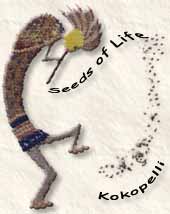 Ever since Man came down from the trees and bade farewell to his ape like descendants, he has collected seeds. First these were for eating, but some invariably got scattered, and if they landed in fertile conditions they grew. And so began a very primitive form of natural selection.
Ever since Man came down from the trees and bade farewell to his ape like descendants, he has collected seeds. First these were for eating, but some invariably got scattered, and if they landed in fertile conditions they grew. And so began a very primitive form of natural selection.
Man slowly changed from hunter-gatherer to farmer.
Traditionally farmers have sown seed, grown crops, collected the best seeds, and have done so for generations. This has led to natural selection, seeds best suited to the farmer's particular growing circumstances. This has led to many tens of thousands of domesticated seed varieties. At least that was the situation up to a century ago. Since then we have had mass extinction of domesticated seed varieties.
Several factors have led to this mass extinction, but in the main the green revolution and seed registration.
Green Revolution led to the elimination of hunger. At least that is the myth. For the farmers who could afford to do so, they grew high yielding varieties, but these were only high yielding if you could afford the inputs, otherwise, the so-called high yielding varieties gave yields that were lower than traditional varieties. Very often the seeds were F1 hybrids, which meant the farmer had to buy fresh seed for each and every growing season. To pay for the seeds, and inputs, the farmer was drawn into the cash economy. Globalisation of this food economy has led to only a a few commercial varieties being grown.
Seeds have to be registered to be recognised. While this has some merit, as we need to have trust in the reliability of a variety, the high registration costs have eliminated all but a handful of commercial varieties. The prohibitively high costs have eliminated all but the big seed companies.
Genetic engineering has led to a further narrowing of genetic diversity.
Dedicated souls across the world have recognised the dangers. In the UK this led to the founding of the Henry Doubleday Research Association, originally to promote organic gardening, but of increasing importance has been their efforts to safeguard traditional seed varieties. In France, Dominique Guillet created the Kokopelli Seed Foundation.
Kokopelli Seed Foundation was created to promote access to open-pollinated seeds. Dominique Guillet was building on an earlier organisation Association Kokopelli.
Association Kokopelli was created in France in March 1999 by a group of people who have been involved since 1987 in the protection of biodiversity, medicinal plants and the production of organic seeds. They created and ran from 1991 to 1998 the Botanical Garden of La Mhotte and Terre de Semences in Auvergne, France: hundreds of traditional varieties were grown for seeds on a 30 acre plot with the help of 45 people going through a process of social rehabilitation.
Association Kokopelli has created in France its own network of organic seed growers who produce seeds of 900 traditional varieties which are then sold all over Europe. A far greater number of traditional varieties are available, free of charge, for members of Association Kokopelli: this collection of seeds is grown by the members for the members who, upon taking up membership, adopt one or more traditional varieties of vegetables.
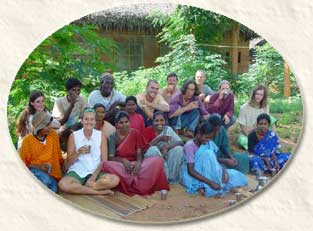 Association Kokopelli has since its foundation been deeply involved in the struggle for food security and the development of sustainable organic agriculture in Third World countries.
Association Kokopelli has since its foundation been deeply involved in the struggle for food security and the development of sustainable organic agriculture in Third World countries.
Association Kokopelli donates seeds to the Third World, in 2001-2002 150,000 packets of seeds were donated.
In 2002, Association Kokopelli launched a new campaign Semences sans Frontières (seeds without frontiers) inviting its members to grow seeds in their own garden to be sent to countries in dire need of good organic seeds.
As well as donating seeds, Association Kokopelli is also involved in establishing seed workshops and seed networks in Third World countries.
On a personal level you may have many motives for growing and saving traditional seed varieties. You may want them for your own consumption. Even if you are growing for your own consumption you will only be doing what farmers have been doing for generations and in doing so you are helping to save a traditional variety, and it is guaranteed to be a lot tastier than what you will find in a superstore.
You may though want to save your seeds to enable a wider distribution, either to your friends and neighbours or via an NGO such as Association Kokopelli to needy Third World Farmers.
To get your seeds widely distributed locally, set up a stall at a local farmers market or local green day or run a Seedy Sunday.
If you are saving seeds for distribution to others and to retain the characteristics of the variety then you will have to be a little bit more persnickety than if it was only for your own consumption.
You need to know how to grow, how to pollinate, how to avoid cross-pollination between varieties, and how to collect and save and store the seeds.
Save Our Seeds, Save Ourselves by Dan Jason of Salt Spring Seeds, is good for starters, but if you are half way serious about growing and saving traditional seeds, then The Seeds of Kokopelli by Dominique Guillet is an absolute must. It is worth it just for the beautiful photos and illustrations.
 I first came across The Seeds of Kokopelli at the
Ambient Picnic in
Guildford on a stall run by Seedy Sunday. On the stall was a range of seeds that people were encouraged to take away for a small donation, a small selection of fruit and vegetables, and a copy of The Seeds of Kokopelli for visitors to leaf through. No sooner had I had a quick flip through The Seeds of Kokopelli, than it was a definite must have. And before the month was out, I had my very own copy in my grubby little mitts.
I first came across The Seeds of Kokopelli at the
Ambient Picnic in
Guildford on a stall run by Seedy Sunday. On the stall was a range of seeds that people were encouraged to take away for a small donation, a small selection of fruit and vegetables, and a copy of The Seeds of Kokopelli for visitors to leaf through. No sooner had I had a quick flip through The Seeds of Kokopelli, than it was a definite must have. And before the month was out, I had my very own copy in my grubby little mitts.
Seedy Sunday? Seedy Sunday is when you get together with your mates on a Sunday, set up a stall, and do your best to widely distribute heritage seeds. If, like Seedy Sunday at the Ambient Picnic, you can have some produce on your stall for the punters to taste, all the better.
But before you set up your stall, you need some seeds, and for the definitive guide to growing, saving, and storing your seeds, you need a copy of The Seeds of Kokopelli.
The Seeds of Kokopelli is arranged by plant species by their Latin botanical names. In case you don't know what these are, you will find a helpful index at the back.
I was astounded by the amount of detail. For each plant, we are told about its origins, how to grow it, sometimes cooking hints, how to collect and save the seeds. For each plant we then have what is the Association Kokopelli seed catalogue. For each seed how much or how many seeds we will get, then a brief description of each variety and its origins, if known.
For some seeds it was as few as 12 seeds, which I would have thought was too few and runs the risk of inbreeding, but I trust Association Kokopelli knows best.
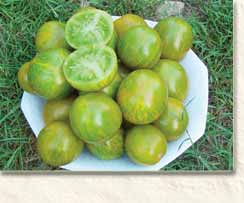 I learnt that the way I have collected tomato seeds, by drying on paper, is not the way to do it. Each tomato seed has a protective coating, you scrape out the seeds, add water, and leave to ferment. You then drain off the water, and dry out the seeds. Leaving to ferment, breaks down the protective coating. But don't leave the seeds to long fermenting, else they will germinate.
I learnt that the way I have collected tomato seeds, by drying on paper, is not the way to do it. Each tomato seed has a protective coating, you scrape out the seeds, add water, and leave to ferment. You then drain off the water, and dry out the seeds. Leaving to ferment, breaks down the protective coating. But don't leave the seeds to long fermenting, else they will germinate.
I have always thought that the larger a tomato, the longer it will take to ripen, but apparently not.
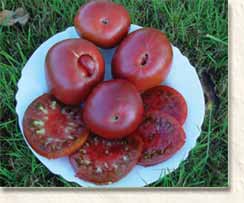 Pages and pages are devoted to tomatoes. I was amazed at the many different colours of tomatoes, these are then in turn subdivided into early and late ripening varieties.
Pages and pages are devoted to tomatoes. I was amazed at the many different colours of tomatoes, these are then in turn subdivided into early and late ripening varieties.
Tomatoes, Lycopersicon lycopersicum are of the Solonaceae family, Solonaceae tribe. Tomatoes were grown by the Incas, high up in the Andes valleys as one of their staple food crops. There are 9 species of tomato within the genus Lycopersicon.
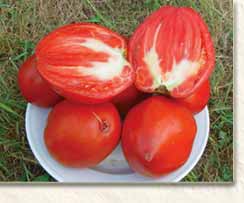 I never knew there was so many varieties of tomatoes, and what surprised me was the number of varieties originating from Siberia, not somewhere one would immediately associate with growing tomatoes.
I never knew there was so many varieties of tomatoes, and what surprised me was the number of varieties originating from Siberia, not somewhere one would immediately associate with growing tomatoes.
Another very large section of The Seeds of Kokopelli is devoted to squashes, another to peppers.
I would differ with Dominique Guillet on the growing of runner beans. It is suggested growing in situ from seed. I have had no problem in the growing, it is just that as soon a the first pair of leaves appear, the succulent plant is immediately devoured by slugs. I find far better, is to start them off, then transplant out when a few inches tall. Not too tall as they start to intertwine around each other. Given a pole and a helping hand, they quickly shoot up the pole out of harms way.
Runner beans are deep rooting. Plant each bean in the top of a toilet roll filled with soil or compost. To fill the roll, push into the soil. The collection of toilet rolls can then be kept in a shallow seed tray or any suitable container.
Dig a trench a couple of feet deep. Line with newspaper. Slowly fill with household and garden waste in layers interleaved with well rotted compost and soil. The top few inches should be soil and/or compost. This makes an ideal water-retentive bed for growing runner beans.
Runner beans, left to go to seed, should be picked before the pods pop, else the seeds are scattered all over the garden. But wait until they rattle in their pods. The beans then need to be left a few days to dry. If biting the seeds leaves barely a mark, then they are dry. Put the beans in a sealed container in a freezer for several days. This destroys pests and parasites.
We eat the beans when the pods are tender and green, other parts of the world wait for the beans to form and eat the beans. Runner beans contain a rare amino-acid, S methyl-cysteine.
The runner bean is a perennial, the roots can be lifted and regrown the next year, but generally fresh beans are sown each year.
The runner bean, Phaseolus coccineus, originates from the Meso-American highlands. It is one of five species, out of 55 of the genus Phaseolus that has been cultivated.
I can recommend two varieties – Painted Lady (from at least 1596) and Scarlett Emperor (Victorian, crossed from the earlier Scarlett Runner c1750).
Seeds which have several pages devoted to them will often have sources of further information listed.
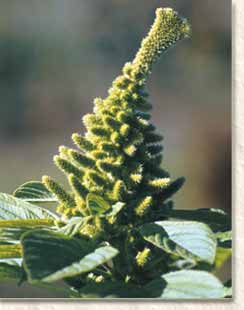 Amaranths, a staple diet of the Aztecs, had virtually disappeared, but you will find several pages devoted to this nutritious grain.
Amaranths, a staple diet of the Aztecs, had virtually disappeared, but you will find several pages devoted to this nutritious grain.
In the early 1970s, John Robinson, a nutritionist at the University of Columbia, concerned at worsening diet and our reliance on only a handful of staple foods and fewer and fewer varieties, decided to look at the diet of early man. He looked at the archaeological evidence for hunter-gatherers and compared with today's hunter-gatherers.
What Robinson discovered, was that our diet was severely curtailed when man changed from hunter-gather to agriculturalist and further still when he changed from subsistence farmer to intensive production of a handful of species such as wheat, maize, and rice destined for urban markets.
As a result of Robinson's work, attempts are being made to reintroduce amaranths, one of the lost plants of the Incas.
There are approximately 65 known species of Amaranths. Some are grown for their leaves, others for their grain. Of the grain variety, two species of Amaranthus, Amaranthus cruentus and Amaranthus hypocondriacus were cultivated in Central America, whilst the peoples of Latin America developed and cultivated only one species, Amaranthus caudatus.
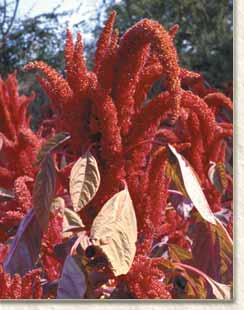 The cultivation of Amaranthus was at its height during the Aztec Empire. For the Aztecs the Amaranthus had an important role to play in nutrition, ritual and had therapeutic value.
The cultivation of Amaranthus was at its height during the Aztec Empire. For the Aztecs the Amaranthus had an important role to play in nutrition, ritual and had therapeutic value.
The sacred nature of the Amaranthus was sufficient for its cultivation to be suppressed by the Catholic Church, whilst at the same time destroying a pagan religion. The writings of Catholic priests at the time bear witness to their horror of Aztec rituals such as the sharing of figurines consecrated by the Aztec people believing they were eating the flesh and bones of the gods.
In 1525, the Catholic Church launched a campaign to systematically destroy the ancient pre-Colombian religious practices, and six years later a bishop brimming over with zeal claimed to have destroyed 20,000 idols and 500 places of worship. Those who continued to practice the Aztec religion were either whipped, or reduced to forced labour in the monasteries or they were executed. When certain gardeners defied the interdiction upon growing Amaranthus in their gardens they were punished by having their hands removed.
The Indian population estimated in 1519 to number 11 million was by 1540 reduced to 6.5 million, victim of genocide and European disease.
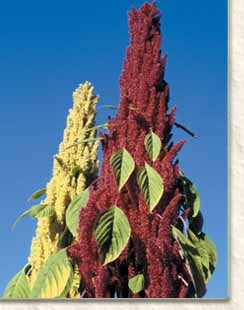 Amaranthus is one of the few plants to use a system of photosynthesis known as C4. Most plants are C3. C4 photosynthesis is highly efficient in conditions of drought, extreme heat and great solar intensity. It allows these plants to convert twice the amount of solar energy into ‘growth’ than plants which use C3, and with the same amount of water.
Amaranthus is one of the few plants to use a system of photosynthesis known as C4. Most plants are C3. C4 photosynthesis is highly efficient in conditions of drought, extreme heat and great solar intensity. It allows these plants to convert twice the amount of solar energy into ‘growth’ than plants which use C3, and with the same amount of water.
Amaranthus is a very efficient sequester of carbon, which makes it a very important plant in today's CO2 driven global warming.
The second advantage of Amaranthus is that it is highly nutritious.
Amaranthus grain contains a high level of protein, between 16%-18%, much more than the cereals of the Poaceae family. The protein found in Amaranthus is one of the most balanced known.
If the ideal protein (according to the UN FAO) is placed at 100, then protein in Amaranthus (as well as in Quinoa) reaches a value of 75, cf corn 44, wheat 60, soya 68 and cows milk 72.
The protein of cereals used in the West is very poor in lysine, one of the amino-acids essential for good health. Amaranthus contains twice as much lysine as wheat and 3 times as much as corn (maize). The US National Academy of Science has established that a mixture of corn flour and Amaranthus flour would give the ideal protein level of 100.
In addition to being high in protein, Amaranthus grain contains a lot of calcium, phosphorous, iron, potassium, zinc, vitamin E and vitamin B.
The high levels of micro-nutrients, ie minerals and vitamins, in Amaranthus leaves places it at an advantage to all other other leaf vegetables. The leaves of Amaranthus are an excellent source of carotene, iron, calcium, protein, vitamin C and other trace elements – the leaves of grain Amaranthus contain 3 times more vitamin C, 10 times more carotene, 15 times more iron and 40 times more calcium than tomatoes, the leaves of Amaranthus contain 3 times more vitamin C, 3 times more calcium and 3 times more niacin than spinach leaves.
Amaranthus palmeri, widely eaten by the Yaqui, Papago and Pima peoples of the Sonora desert in America, contains 3 times more calories, 18 times more vitamin A, 13 times more vitamin C, 20 times more calcium and 7 times more iron than lettuce.
A lot of work has gone into producing The Seeds of Kokopelli, truly a labour of love.
The development of the family garden, and seed autonomy, is one of the fundamental prerequisites of the revolution to come: the best way to fight the multinationals is to bypass them!
Highly recommended.
The Seeds of Kokopelli is available in English and French. Copies will be available in Portuguese and Spanish.
Kokopelli? Kokopelli is a mystical figure of the Americas. As he wanders he plays his flute and sows his seeds.
Also worth reading
Jose Bove and Francois Dufour, The World is Not for Sale: Farmers Against Junk Food, Verso, 2001
Brian Donahue, Reclaiming the Commons: Community Farms and Forests in a New England Town, Yale University Press, 1999
Andrew Kimbrell (ed), Fatal Harvest: The Tragedy of Industrial Agriculture, Island Press, 2002
Corby Kummer, The Pleasures of Slow Food, Chronicle Books, 2002
Frances Moore Lappé, Joseph Collins and Peter Rosset, World Hunger: 12 Myths (2nd Ed), Food First Books, 1998
Frances Moore Lappé & Anna Lappé, Hope's Edge: The Next Diet for a Small Planet, Tarcher Putnam
Pauline Pears (ed), HDRA Encyclopedia of Organic Gardening, Dorling Kindersley, 2001
Carlo Petrini, Slow Food, Columbia University Press, 2004
Jeffrey M Smith, Seeds of Deception, Yes! Books, 2003